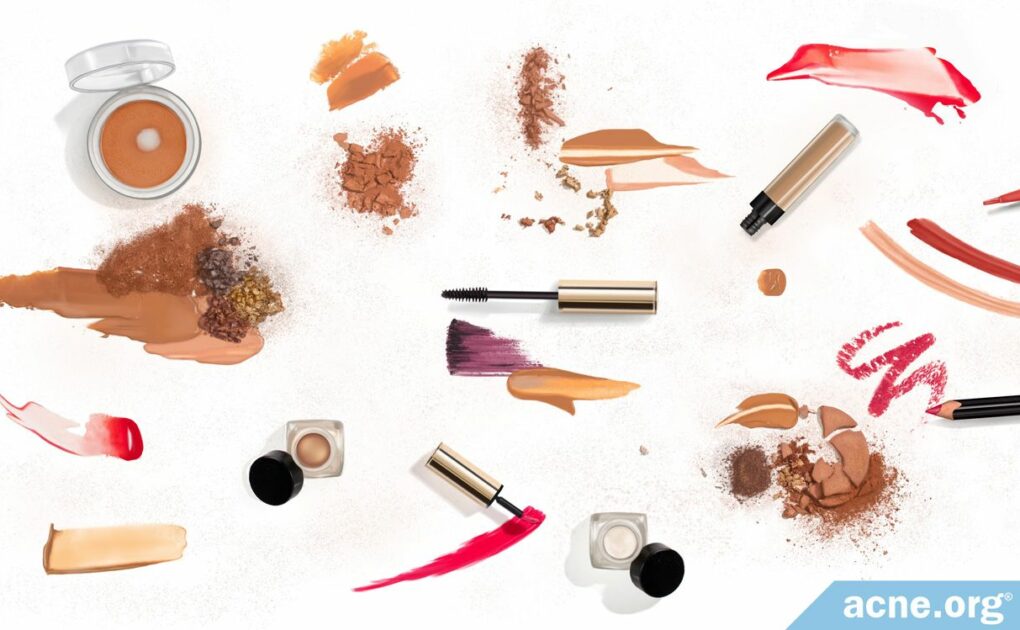While Makeup Ingredients Are Sometimes Pore-clogging, They Are Normally Non-toxic

The Essential Info
The makeup industry has come a long way. Most makeup formulations today include safe ingredients, which are typically non-comedogenic (won’t clog pores), non-irritating, and hypoallergenic.
This is in contrast to the past where pore-clogging makeup could often keep people in a cycle of acne: someone gets acne–makeup is used to cover it up–makeup causes more acne–more makeup is needed to cover it up–and on and on.
However, even with today’s improved products, some individuals may experience skin irritation when using certain kinds of makeup products. If you find that your acne started getting worse in the months after you started using a particular makeup, your makeup just might be at fault. In that case, stop using the makeup, get yourself cleared up completely, and then reintroduce a new safe brand of makeup and see how things go.
How to choose a “safe” makeup:
- If you can find a makeup product that advertises that it is specifically designed for acne-prone skin, this may be your best bet, since it is very likely that the formulators of the product are keeping acne in mind.
- Opt for a large brand name product specifically targeting a younger demographic. The formulators of these products are more likely keeping in mind the acne-prone skin of their younger customers.
- Avoid makeup aimed at older women, which often contain greasier ingredients that can clog pores.
- You may want to avoid products that contain bismuth oxychloride, which some people claim irritates their skin. However, if you are currently using a product that contains bismuth oxychloride and you experience no irritation, it’s probably fine.

The Science
- Properties of Different Makeup Products
- Toxicity of Makeup Ingredients
- General Advice for Choosing Makeup Products to Be Used on Acne-prone Skin
This article will touch on the various types of makeup products, how they are made, and what, if anything, there is to watch out for.
Properties of Different Makeup Products
Makeup primers
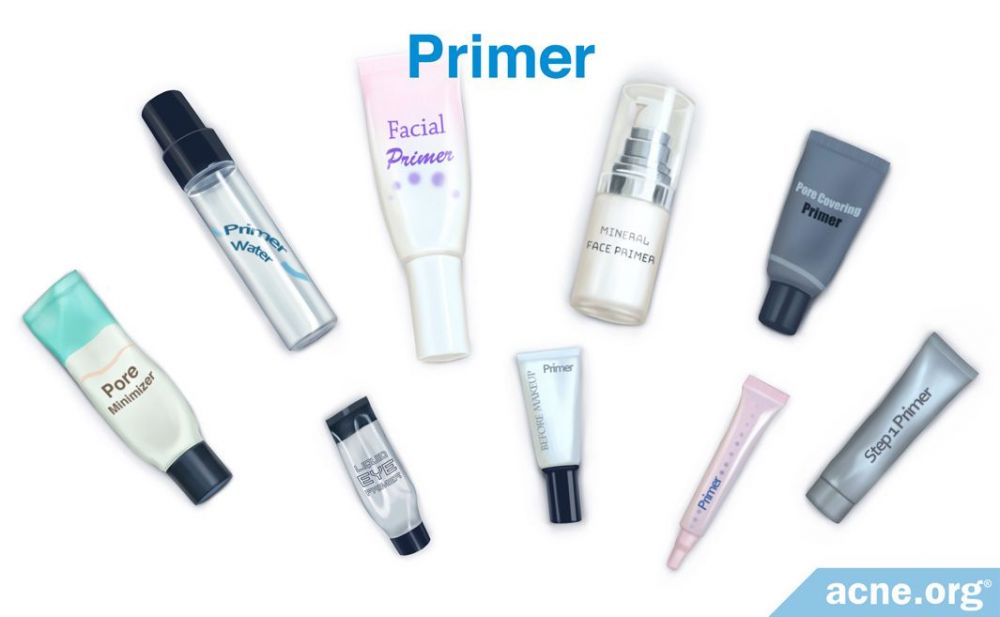
Makeup primer is a cream, gel, or lotion that is applied on the face before other types of makeup. The main roles of a makeup primer are to prepare the skin for makeup by smoothing small wrinkles and large skin pores, and to ensure that it stays longer on the face, especially in hot and humid weather. It can also act as a moisturizer or, depending on the ingredients in the primer, absorb excessive sebum (skin oil) from the face. The removal of excess sebum provides a matte finish to the skin. Primer is composed of water and silicone compounds (more below about them) and optionally may contain emollient ingredients, vitamins A, C, and E, hydrating substances (e.g., sodium hyaluronate), UV-absorbing ingredients, which protect the skin from the sun’s rays, and different types of herbal extracts.
Makeup foundations

Foundations are one of the first makeup products applied to the skin to create a smooth, even complexion that can hide redness and, to some extent, blemishes. Foundations can be in the form of liquids, gels, creams, or sticks.1
The major ingredients of liquid foundations are divided into two groups.
- Water-based foundations contain a mixture of water and mineral oil or silicone. In the past, makeup was made with vegetable oils. However, due to vegetable oil’s potential to clog pores, silicones are now used in their place. Water-based foundations contain more water (50 – 60%) than silicone, which is the reason they are considered water based. These foundations are more suitable for people with normal to oily skin.
- Oil-based foundations also contain a mixture of water and oil but more commonly of water and silicone. They contain more oily substance than water (30 – 45%). Since silicone is a synthetic form of oil, such foundations still are regarded as oil based and are more suitable for people with dry skin.1
Other main ingredients of foundations:
- Filling ingredients, including talc, mica, sericite, and bismuth oxychloride, help to spread the covering ingredients onto the face.
- Covering ingredients include titanium dioxide, zinc oxide, and kaolin, which is a type of clay. These covering ingredients produce a white color that helps to cover skin imperfections. Titanium dioxide and zinc oxide can also provide some protection from the sun. There are four levels of coverage.
- Sheer coverage provides 8 – 13% coverage and only partially covers skin imperfections.
- Light coverage provides 13 – 18% coverage and can help even skin tone and hide freckles.
- Medium coverage provides 18 – 23% coverage and can cover discoloration, red marks, and blotchiness.
- Full coverage provides 23 – 35% coverage and can completely cover hyperpigmentation, birthmarks, scars, and vitiligo, which is a skin condition that causes depigmented patches of skin.
- Coloring ingredients include iron oxides that are red, yellow, and black. These mix in with foundation to create different shades that resemble a wide range of natural skin colors.
- Unifying ingredients include a variety of substances that help emulsify other ingredients to create a uniform foundation that does not separate into individual components. These ingredients, which are also called emulsifiers, help the water portion and the oil or silicone portion of the foundation stay together, instead of separating out like water and oil do if you put them in a glass.
- Preservatives comprise a variety of substances that help prevent the growth of bacteria and fungi.
- Other ingredients include vitamins, antioxidants, anti-aging ingredients, sunscreens, moisturizers, and herbal extracts. These help provide some additional skin benefits.1
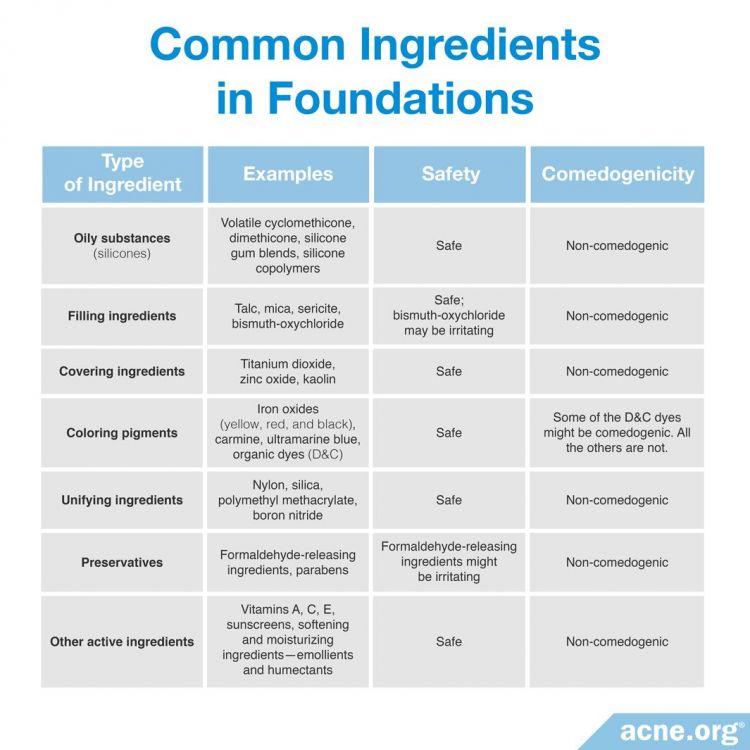
Face powders
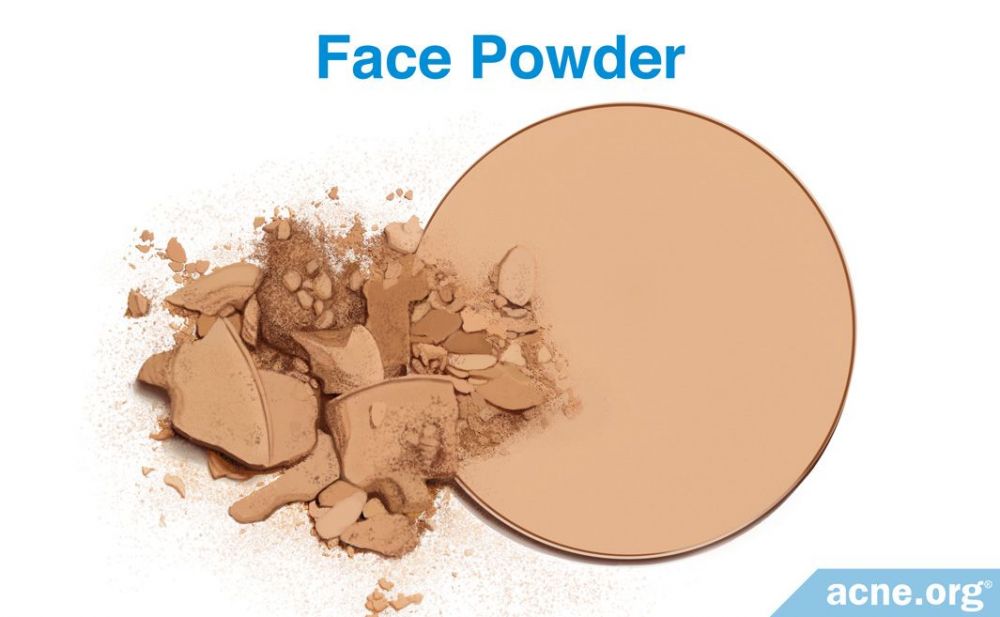
Face powders come in two forms: free powders and pressed powders (cakes). Face powders work by covering complexion imperfections and absorbing excess oil from the skin, providing a matte finish and smoothness to the skin. These powders are applied after the application of foundation. The composition of face powders is similar to the constitution of foundations, except they do not contain water or silicones. The main ingredients of face powders include:1
- Filling ingredients, such as talc and sericite, help evenly spread face powders on the surface of the skin.
- Chalk or kaolin absorb moisture and oil from the skin’s surface.
- Magnesium stearate ensures that the powder stays on the skin.
- Covering ingredients comprise zinc oxide and titanium dioxide.
- Coloring ingredients include iron oxide and carmine.
- Unifying ingredients include nylons, polyamides, and silica.
- Preservatives include a variety of substances that prevent the growth of bacteria and fungi.
Concealers
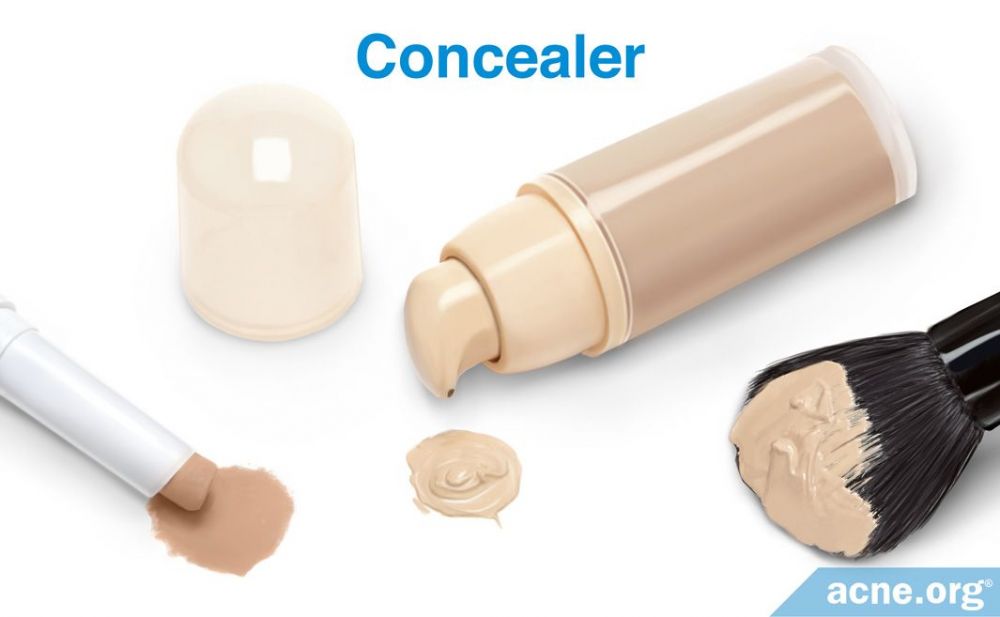
Concealers are color correctors that are only applied to problematic areas of the skin, such as dark circles, age spots, large pores, acne lesions, and red or dark marks left after an acne lesion heals. Concealers can be applied before or after foundation, depending on personal preference. Their composition is similar to that of foundation and face powders, but they generally contain more covering ingredients. When formulated for normal skin types, concealers can be thick and greasy because they contain additional oils, like castor oil, macadamia oil, or shea butter, but are replaced with silicones when formulated for acne-prone skin.
Blushes
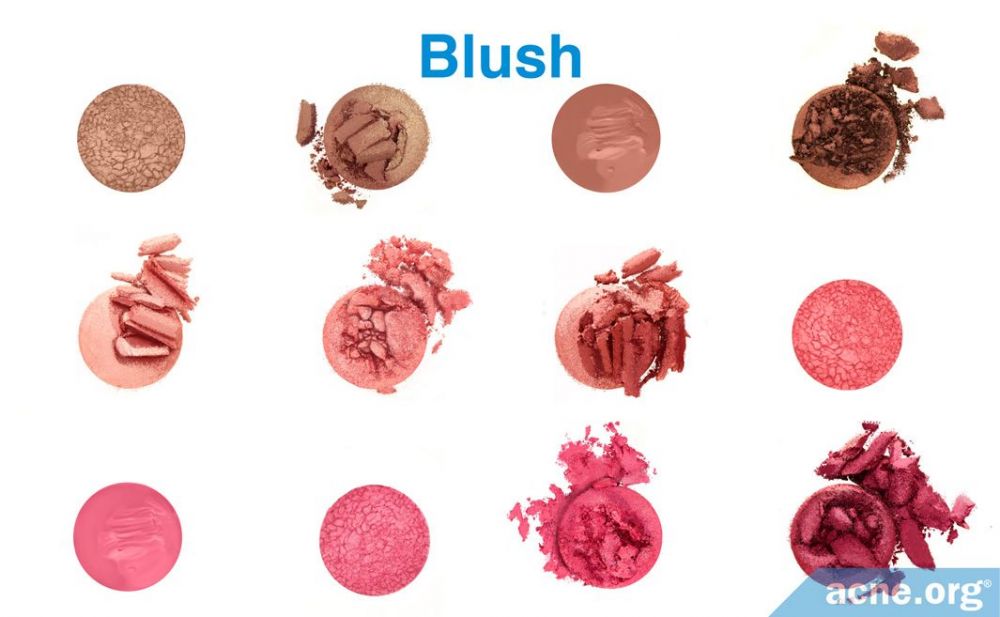
Blushes mainly come in the form of pressed powders that provide one of three main finishes: matte, shimmering, or satin. The main ingredients of blushes are red-colored talc powder, mica, adhering ingredients, i.e., zinc or magnesium stearate, and unifying ingredients, namely, silica boron nitride. Compared to foundations and powders, blushes may contain a wide variety of pigments – not just iron oxides – but also organic dyes, such as D&C Red pigments and FD&C Yellow pigments.
Mineral makeup
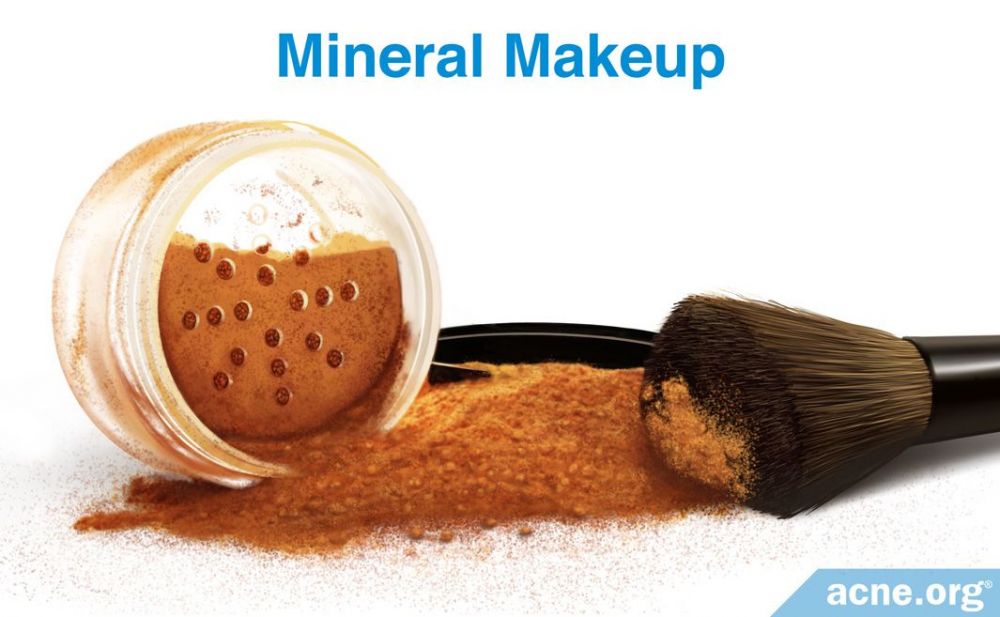
Mineral makeup is composed only of minerals, including substances like talc, zinc oxide, titanium dioxide, and iron oxides. To produce mineral makeup these minerals are finely ground into a powder. Mineral makeup does not contain any oils, waxes, fragrance, or preservatives, and therefore some people consider it safe compared to conventional makeup. However, equally safe versions of conventional makeup are also available.
Toxicity of Makeup Ingredients
Research investigating the toxicity of several makeup ingredients has found that the overwhelming majority of all makeup ingredients are safe to use.
Silicones
Silicones is a general name for compounds that contain silicon and oxygen. Silicones replace oils in makeup products because of their oily properties, but do not clog pores like oils. There are two main categories of silicones.1 – 3
- Volatile silicones are substances that quickly evaporate after application to the skin. When evaporated from the skin, they leave a thin coating of makeup that is evenly distributed across the entire face. Volatile silicones are most commonly found in foundations, and their purpose is to combine the other ingredients in makeup. They also allow for fast spreading of the product onto the skin. Examples of volatile silicones include cyclosiloxanes (cyclomethicone). On the internet, some people have raised concerns that volatile silicones are bad for the environment, but research has not proven these concerns to be true. From what we currently know, they are considered safe.
- Polymeric silicone compounds are substances that do not evaporate after application of the makeup. They also mix other ingredients in makeup and make it easier for people to spread on the skin. Polymeric silicones are preferred because manufactures find them easier to create than volatile silicones, and they have a smooth, non-greasy feel. Research shows that such compounds also are safe to use.
Filling ingredients
Filling ingredients are added to makeup to help spread it across the face. Let’s examine the safety profile of the most common filling ingredients in makeup.
- Talc is a clay mineral composed of hydrated magnesium silicate. Some research has found that cosmetic talc usage is correlated with ovary tumors – and inhalation, with lung diseases. However, these studies observed that only excessive use of talc for extended periods of time was associated with cancer and lung diseases. Further, study correlation does not prove that talc caused these diseases, just that talc usage was associated with them. Researchers have not performed studies examining the use of talc in makeup products, and current knowledge suggests that makeup products containing talc contain it at a low concentration, and are therefore non-irritating, do not clog pores, and are safe to use.4
- Mica is a silicate mineral that is used as a fine powder in cosmetic products. It is non-irritating, does not clog pores, or cause acne. As mica is harvested from the earth, it can contain small amounts of heavy metals that can be toxic to humans. However, the Food and Drug Administration (FDA) regulates the amount of heavy metals in mica, and therefore it is safe to use in cosmetic products like makeup.
- Sericite is a finer ground version of mica. Like mica, it is non-irritating, and does not clog pores or cause acne.
- Bismuth oxychloride is a white bismuth compound added as a filling ingredient to several cosmetic products. Research demonstrates that bismuth compounds have a low toxicity due to their limited ability to dissolve in water and to react with other molecules. However, it is common to see personal reports on internet forums from people claiming that the bismuth oxychloride in mineral makeup causes allergies, irritation, and itch. Generally, science has shown that bismuth oxychloride is safe to use, but some people who use it may experience skin irritation. It is unknown whether bismuth oxychloride clogs pores or causes acne.5,6
Covering ingredients
Covering ingredients are added to makeup to even skin tone, partially cover skin imperfections, and may also help protect against harmful rays from the sun. However, some covering ingredients are not safe for cosmetic use.
1. Titanium dioxide (TiO2) is a chemical used to cover skin blemishes and act as a sunscreen by absorbing harmful UV rays. Researchers are currently undecided whether titanium dioxide is safe to use in cosmetic products or sunscreens. This is because it provides photocatalytic activity, meaning that in the presence of UV light, moisture, and oxygen, TiO2 creates chemicals called reactive oxygen species (ROS), which can destroy skin components and cause irritation if they travel to the deeper sections of the skin. The size of TiO2 particles determines how severe the photocatalytic activity is – the smaller particles being more photocatalytic. Makeup and sunscreens contain the smallest TiO2 particles, and therefore are highly photocatalytic. However, if TiO2 is retained on the surface of the skin, the ROS it creates will not cause harm to it, whereas they will harm the skin if present in deeper skin layers. Two studies examined whether TiO2 can penetrate and travel to deeper skin layers:
Expand to read details of studies

A 1999 study published in the journal of Skin Pharmacology and Applied Skin Physiology investigated how far micro-sized TiO2 particles from sunscreen can penetrate through the skin. To perform this study, the researchers applied sunscreen containing micro-sized TiO2 onto the left forearm and sunscreen without TiO2 on the right forearm of participants for four days. During the first three days, the participants applied the sunscreens five times, and once on the fourth day. Then, they examined how deeply the particles traveled into the skin. The researchers found that the highest amount of TiO2 was found in the uppermost layer of the skin, and that it did not travel into deeper skin layers. Because TiO2 is confined to the uppermost layer of the skin and does not penetrate the deeper layers, the researchers concluded that it is safe to use in cosmetic products.7
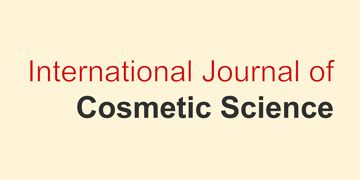
A 1999 study published in the International Journal of Cosmetic Science examined how far TiO2 could travel into the skin. Performed similarly to the previous study, this one also found that topically applied TiO2 remains in the uppermost layer of the skin and does not travel deep into the skin’s living tissue. Therefore, the researchers also concluded that TiO2 is safe to apply to the skin.8
2. Zinc oxide is a covering agent in makeup and a UV-light-reflecting agent in sunscreens. It can treat skin conditions, including wounds, injuries, acne, and diaper rash. It is considered safe, non-irritating, and does not clog pores or cause acne.9
Unifying ingredients
Unifying ingredients help to keep the different ingredients in makeup mixed, making for a uniform foundation. Essentially, unifying ingredients ensure that the water and oil components of makeup products remain mixed, instead of separating out in the makeup container. The two most common unifying ingredients used in makeup are boron nitride and nylon, and both are considered safe to use.
- Boron nitride is a chemical used as a slip modifier in a variety of different cosmetic products. A slip modifier is an agent used to help the makeup spread more smoothly and easily onto the skin. The Cosmetic Ingredient Review Expert Panel has reviewed several studies examining the chemistry, animal, and clinical data on boron nitride and determined that its cosmetic use is safe to use. Further, there are no reports about its ability to clog pores or cause acne.10
- Nylon is a synthetically created molecule that is added to a variety of cosmetic products so that they can absorb liquids, increase the volume of the product, and add a thin coating to the skin. Research has found that nylon cannot penetrate deeply into the skin, so researchers consider it harmless. However, scientists have not studied the ability of nylon to clog pores or cause acne, and therefore needs to be tested to confirm whether it can be used on problematic skin.11
Preservatives
Preservatives are included in cosmetic products because they prevent the unwanted growth of bacteria and fungi. There are two main types of preservatives used in makeup.
1. Parabens are chemicals commonly used as preservatives not only in makeup, but also in other cosmetics, toiletries, and pharmaceutical medications. Research has found that they carry a relatively low toxicity profile and therefore are safe to use. However, parabens can mimic the action of the female sex hormone, estrogen, and can cause some adverse effects in humans, including reproductive tract abnormalities in males and an increased risk of breast, testicular, or prostate cancer. A 2005 study published in the journal Critical Reviews in Toxicology goes into more detail:
Expand to read details of study

A 2005 study published in the journal of Critical Reviews in Toxicology found that daily exposure to parabens may pose some risk to human health. No studies examine the effect of parabens on acne, but because they mimic estrogen, it is possible that they act similarly to estrogen to reduce the production of sebum. Consequently, it is unlikely that parabens would cause acne outbreaks.
2. Formaldehyde-releasing ingredients are chemicals that gradually release small amounts of formaldehyde to destroy bacteria and fungi growing in cosmetic products. Examples of these preservatives include DMDM hydantoin, diazolidinyl urea, imidazolidinyl urea, methenamine, quaternium-15, and sodium hydroxymethylglycinate. Formaldehyde is a reactive chemical, and it may cause skin irritation and allergic reactions although present in small amounts in cosmetic products. However, it does not clog pores.12
Fragrances
Occasionally, producers of makeup incorporate fragrances into makeup products to improve the smell. However, some people are sensitive to these fragrant chemicals and may develop allergies to them. A 2000 study published in the British Journal of Dermatology reviewed the data from 25,545 patients that had undergone allergy testing during a period of 16 years. They found that 8.5% of females and 6.7% of males had an allergy to a chemical used for fragrance.
Examples of allergenic fragrances include eugenol, isoeugenol, oakmoss, alpha-amyl cinnamaldehyde, geraniol, hydroxycitronellal, and cinnamaldehyde. It is well known that any kind of skin irritation aggravates acne, so it is advisable to use fragrance-free makeup for acne-prone skin.13
General Advice for Choosing Makeup Products to Be Used on Acne-prone Skin
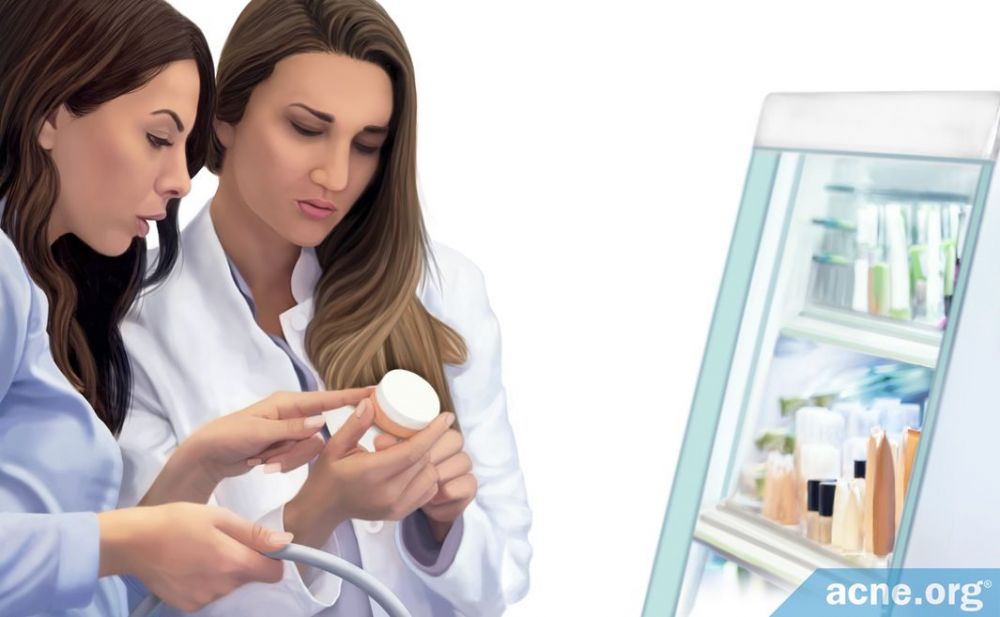
From all the points made above, it may be concluded that today’s makeup products contain relatively safe, carefully chosen ingredients. Most reputable cosmetic companies choose ingredients which are non-irritating, non-comedogenic (non-pore-clogging), non-acnegenic (will not cause acne), and hypoallergenic (will not cause an allergic response). When choosing makeup, it is safer to select products which contain such characteristics on the label. Also, companies such as Neutrogena® and Almay® (note: Acne.org is not affiliated with these companies) offer makeup product lines specifically designed for acne-prone skin. If you prefer to use regular makeup products, it may be helpful to follow certain guidelines, although official dermatology does not provide recommendations. If you suffer from acne outbreaks, it would be better to avoid heavy makeup products, that is to say, those which are labeled as “long lasting,” “full coverage,” “24-hour wear,” etc. For foundations, it is best to choose sheer (light) coverage and scrutinize the ingredients, watching out for any which may be comedogenic. You may find the list of comedogenic ingredients here.
If you are in the process of clearing your acne with a chosen daily routine, such as the Acne.org RegimenTM, it is advisable not to incorporate makeup. It would be difficult to determine whether regress occurs because of makeup application or another factor. Once you figure out how to keep your skin clear, it is OK to include makeup in your regimen. Several studies proved that patients with acne or other dermatological disorders can benefit and improve their quality of life by using makeup. You can read more about the effects of makeup on patients with acne-affected skin here.
References
- Handbook of Cosmetic Science and Technology. Third edn, (Informa Healthcare, 2009). https://books.google.com/books/about/Handbook_of_Cosmetic_Science_and_Technol.html?id=YvYqa1fptDcC
- Goddard, D. Principles of Polymer Science and Technology in Cosmetics and Personal Care. (Marcel Dekker, Inc., 1999). https://rgmaisyah.files.wordpress.com/2009/02/principles-of-polymer-science-and-technology-in-cosmetics-and-personal-care.pdf
- Johnson, W. Jr. et al. Safety Assessment of Cyclomethicone, Cyclotetrasiloxane, Cyclopentasiloxane, Cyclohexasiloxane, and Cycloheptasiloxane. Int J Toxicol 30, 149S – 227S (2011). https://www.ncbi.nlm.nih.gov/pubmed/22247236
- Wehner, A. P. Biological Effects of Cosmetic Talc Food Chem Toxicol 32, 1173 – 1184 (1994). https://www.ncbi.nlm.nih.gov/pubmed/7813991
- Mohan, R. Green Bismuth. Nat Chem 2, 336 – 337 (2010). https://www.ncbi.nlm.nih.gov/pubmed/21124518
- Lansdown, A. B. Physiological and Toxicological Changes in the Skin Resulting from the Action and Interaction of Metal Ions. Crit Rev Toxicol 25, 397 – 462 (1995). https://www.ncbi.nlm.nih.gov/pubmed/8845064
- Lademann, J. et al. Penetration of Titanium Dioxide Microparticles in a Sunscreen Formulation into the Horny Layer and the Follicular Orifice. Skin Pharmacol Appl Skin Physiol 12, 247 – 256 (1999). https://www.ncbi.nlm.nih.gov/pubmed/10461093
- Pflucher, F., Hohenberg, H., Holzle, E., Will, R., Diembeck, W. & Gerls-Barlag, H. The outermost stratum corneum layer is an effective barrier against dermal uptake of topically applied micronized titanium dioxide. Int J Cosmet Sci 21, 399 – 411 (1999). https://www.ncbi.nlm.nih.gov/pubmed/18503454
- Schwartz, J. R., Marsh, R. G. & Draelos, Z. D.Zinc and Skin Health: Overview of Physiology and Pharmacology. Dermatol Surg 31, 837 – 847 (2005). https://www.ncbi.nlm.nih.gov/pubmed/16029676
- Fiume, M. M. et al. Safety Assessment of Boron Nitride as Used in Cosmetics. Int J Toxicol 34, 53S – 60S (2015). https://www.ncbi.nlm.nih.gov/pubmed/26684796
- Safety Assessment of Nylon as Used in Cosmetics. (Cosmetic Ingredient Review). https://www.cir-safety.org/supplementaldoc/safety-assessment-nylon-used-cosmetics-0
- Golden, R., Gandy, J. & Vollmer, G. A Review of the Endocrine Activity of Parabens and Implications for Potential Risks to Human Health. Crit Rev Toxicol 35, 435 – 458 (2005). https://www.ncbi.nlm.nih.gov/pubmed/16097138
- Buckley, D. A. et al. The frequency of fragrance allergy in a patch-test population over a 17-year period. Br J Dermatol 142, 279 – 283 (2000). https://onlinelibrary.wiley.com/doi/abs/10.1111/j.1600-0536.2007.01287.x
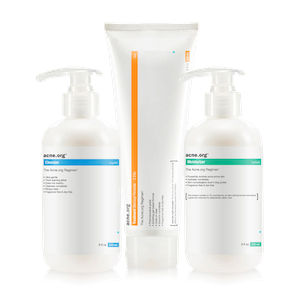 Acne.org Products
Acne.org Products